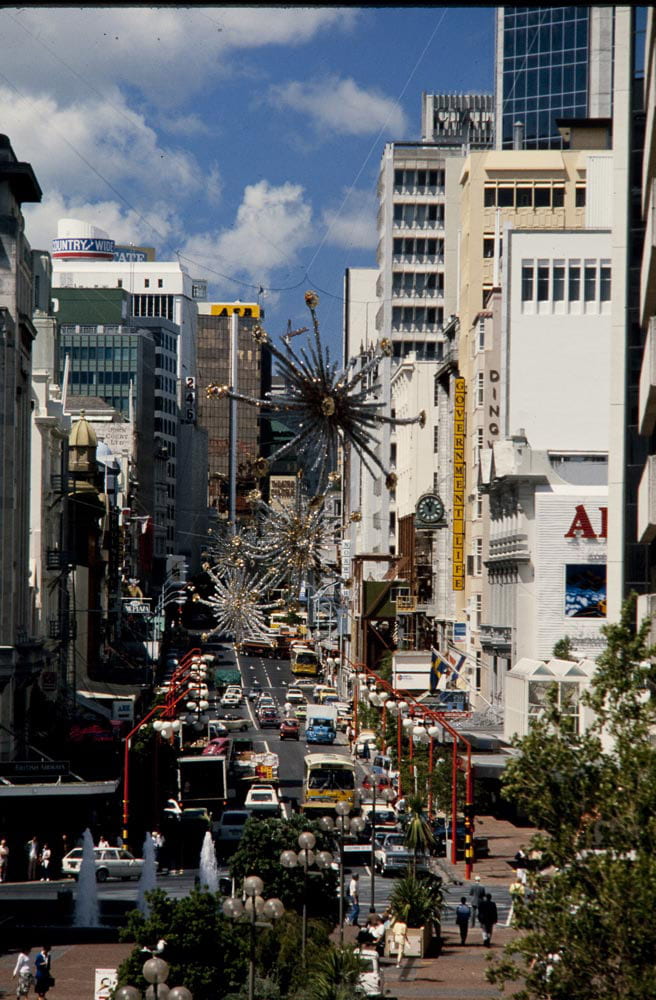Part Five
After the Trial Mall: Queen Street’s Stagnated Development
by Nancy Mitchelson*
In August of 1979, things were still looking hopeful for a proposed pedestrian mall in Queen Street, following the carnival-like, week-long trial in May. Furthermore, the closing off of the Wellesley/Victoria street block was approved by the ACC policy and finance committee.[1]
So, what happened?
Bureaucracy. A rift in Auckland Council developed between those who wanted to see a permanent mall with a bus running through it and those who wanted a strictly pedestrian zone. A new bus route, or traffic management plan, was needed for the city before permanent progress could be made.[2]
However, the next year, a hard and fast decision was made regardless. In the wake of almost a decade of stalling, accommodating, and decision making, a pedestrian mall was nixed. A programme of footpath widening and tree planting, as well as pedestrian accommodation in Darby Street, was approved instead.[3] This new development would cost 670,000 dollars, money which was originally sanctioned by the loans board for the mall, who took convincing to repurpose for a mere street-widening programme.[4] It is this footpath widening, in some and not all areas, which remains a feature of Queen Street today.
Yet, at the time, Queen Street businessmen were still not satiated. Frank Carter of Stones Shoe Shop, the mall’s most vocal critic, certainly wasn’t. He bemoaned in the New Zealand Herald “why tinker with it, when it is working well already?”[5] This view was echoed in a letter to town planner, J.R Betts, from the secretary of the Central Auckland Business Association: “the extensive widening of the footpath on the eastern side of the street, and the consequent narrowing of the carriageway is regarded by a number as being a retrograde step.”[6] At this point, the absolute infiltration of business interests in town planning had reached an apex, with a large group of Queen Street businesses threatening legal action at the High Court, or Privy Council, if original proposals for a Queen Street pedestrian mall went ahead.[7]
This reaction may have been the straw that broke the camel’s back in terms of any kind of pedestrian mall for Queen Street. Sealing the casket in 1981 was the newfangled computer simulation TOMCAT model, which proved there was a lack of capacity for traffic in parallel streets.[8]
Resentment lingered for those most attached to the plan. A 1983 letter from J.R Betts, to a Mr. Hassan of Invercargill, seeking advice for their city’s own mall reads,“the one important lesson to learn is never undertake a trial closure… our trial resulted in a polarisation of public attitudes. The controversy that arose from some elements of the trial was sufficient to result in the abandonment of the scheme.”[9]
And yet in February 1993, the wheel was to be reinvented once again. The Council Executive and Mayor Leslie Mills wrote to the architectural division, which at that point still included council veteran J.R Betts. They wanted to look into closing the Queen Street carriageway from the North to the South, with East and West traffic routes maintained. The Council Executive explained, “each block or area would have a theme,” the letter read, “e.g, ethnic, pioneer, futuristic etc.”[10]
After being burned? Or maybe disappointed so many times, John Betts appeared to be jaded or weary about any kind of pedestrian mall on Queen Street and he had changed his thinking on the subject. Rather than endorse this new attempt at a pedestrian mall, Betts advocated instead for pedestrian blocks adjacent to the main road, which “provided flexibility for the future planning of Queen Street.”[11]

A pedestrianised Queen Street of the future? Image accessed at https://www.nzta.govt.nz/roads-and-rail/rapid-transit/auckland-light-rail/
This brings us to today. In November 2018, council voted to ban vehicles from Queen Street, apart from light rail lines, after a series of closed street trials. An idea championed by Sir Dove-Myer Robinson and investigated by Leslie Mills, is now being solidified by Phil Goff. One can only wonder if Auckland councillors today have looked into the processes of the past. History can be a wheel, but sometimes history can also be a pair of pedestrian legs marching forward in progress.
*Nancy Mitchelson was awarded first-class honours in History at The University of Auckland, having completed a Bachelor of Arts. She was one of four students awarded a 2019 Summer Scholarship at The University of Auckland out of a highly competitive field and her award was funded by a Jonathan and Mary Mason Scholarship in Auckland History. Her research project focused on the efforts to Pedestrianise Queen Street in May of 1979.
[1] “Qualified Approval for Mall,” NZH, 11 August, 1979.
[2] “To bus or not to bus? Mall Query,” NZH, 16 August, 1979.
[3] “Queen Street Plan,” Auckland Star, 15 July, 1980.
[4] Queen Street Mall, 1978-1980, Works Department Classified Subject Files, ACC 219 Box 925 Item 925h Record 64-141-05 Part 3 Record ID 420307, Auckland Council Archives.
[5] “Caution Greets Queen Street Plan,” NZH, 15 July, 1980.
[6]Queen Street Mall, 1978-1980, Works Department Classified Subject Files, ACC 219 Box 925 Item 925h Record 64-141-05 Part 3 Record ID 420307, Auckland Council Archives.
[7] “Law suit may halt city mall,” Auckland Star, 3 September, 1980.
[8] “Queen Street Mall Impractical,” NZH, 12 June, 1981.
[9] Queen Street Mall, 1980-1984, Works Department Classified Subject Files, ACC 219 Box 926 Item 926a Record 64-141-05 Part 4 Record ID 420308, Auckland Council Archives.
[10] Queen Street – Design Studies, 1993-1993, Architectural Division Files, ACC 504 Box 6 Item 6j Record ID 461145, Auckland Council Archives.
[11] Urban Design – Queen Street Mall, 1993-1993, City Planning Group Classified Subject Files, AKC 013 Box 124 Item 124b Record PN-3547 Part 1 Record ID 554962, Auckland Council Archives.

